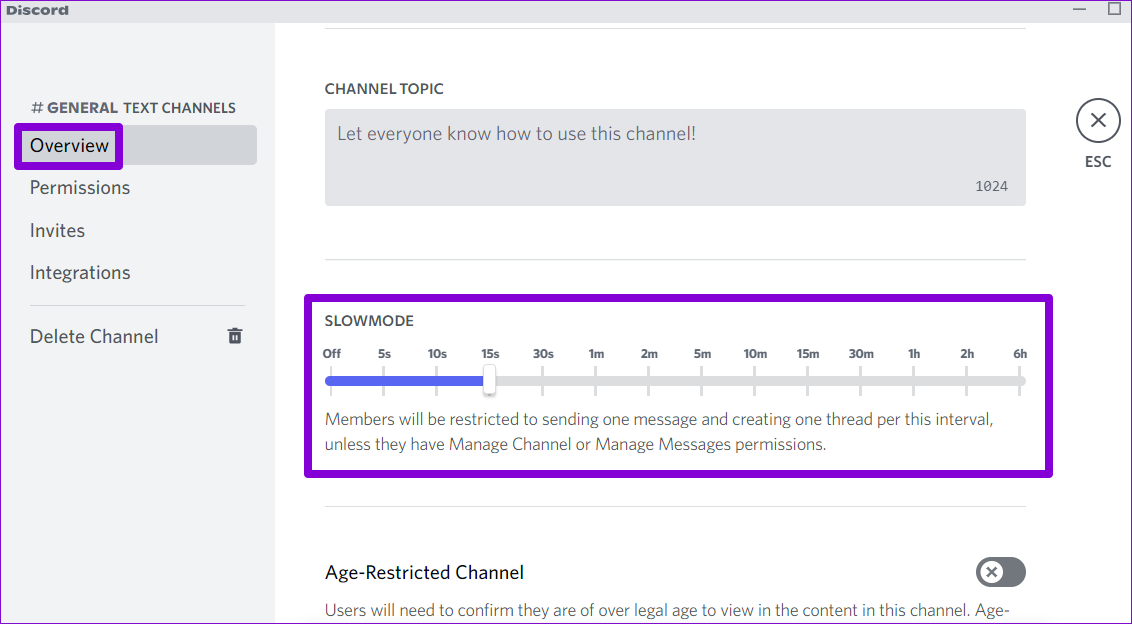How to Enable or Disable Slow Mode on Discord
If you’re a member of a public Discord server, you already know how quickly conversations between a few people can flood a channel with messages. This can make it difficult for server administrators to moderate conversations. That’s the problem that Discord’s slow mode aims to solve.

We’ll show you how to enable or disable slow mode on Discord. Before we do that, let’s understand what exactly Discord’s slow mode feature is and why it’s useful.
What is slow mode in Discord and how is it useful?
Discord’s Slow Mode feature helps limit the number of messages a user can send in a channel. For example, if you send a message in a channel that has slow mode active, you must wait for the cooldown period to expire before sending another one. The cooldown can be as short as five seconds or as long as six hours. If you try to send another message during the idle time, you’ll get a notification and a screen shake.

Discord’s slow mode helps server admins slow things down and reduce spam, especially on large servers. Of course, the slow mode limitations don’t apply to server owners, admins, and users with permission to manage the channel or messages. You can continue to send messages as usual.
Now that you have a rough idea of what slow mode is, let’s see how to enable or disable it from desktop and mobile.
How to enable or disable slow mode in Discord on desktop
Only a server owner, admin or moderator can configure slow mode on Discord. You can use the steps below to enable or disable slow mode in Discord on both PC and Mac.
Step 1: Open the Discord app or navigate to the Discord web client in your browser. Then log into your account if you haven’t already.
Step 2: Go to the channel where you want to enable or disable slow mode. Click the gear-shaped icon next to the channel name. This opens the channel settings.

Step 3: In the Overview section, use the slider to set the Slow mode duration. You can set it to any time between five seconds and six hours.

If you want to disable slow mode, move the slider to the Off position.

Step 4: After enabling or disabling slow mode, click the Save Changes button at the bottom right corner.

After slow mode is activated for a channel, you will see the message “Slow mode is activated” at the bottom of the chat screen.

If you’re exempt from this restriction, you’ll see the message “Slowmode is on, but you’re immune.” So you can send messages without worrying about the countdown timer.
How to enable or disable slow mode in Discord for Mobile
It is possible to enable or disable slow mode on a Discord channel through its mobile app. Discord’s interface is almost identical on Android and iPhone. So the following steps will work on both platforms.
Step 1: Open the Discord app on your phone.
Step 2: Navigate to the channel where you want to enable or disable slow mode. Long press on the channel name and select Edit Channel from the menu that appears.


Step 3: On the Channel Settings page, scroll down to the Slowmode Cooldown section. Move the slider to the right to set a slow mode interval. The cooldown can be anywhere from 5 seconds to 6 hours.

Alternatively, if you want to disable slow mode for the channel, move the slider all the way to the left.

Step 4: After enabling or disabling slow mode, tap Save on the top right to save the changes.

Go back to your channel and you will see the message “Slowmode is enabled” at the bottom. Unfortunately, you’ll have to repeat these steps for each channel separately as there is no option to enable a server-wide slow mode on Discord.

Slowly and steadily
Discord’s slow mode feature can help moderate content on the Discord server. However, it can also sometimes interrupt the flow of conversation.
Enabling slow mode isn’t the only way to moderate conversations on a Discord server. You can always use Discord moderation bots to protect your server. Alternatively, you can appoint server administrators to enforce the rules by silencing or banning troublemakers.